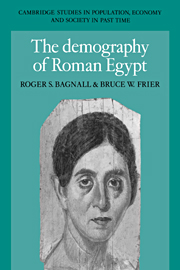Book contents
- Frontmatter
- Contents
- List of figures
- List of tables
- Foreword
- Preface
- A note on references and abbreviations
- 1 The census returns
- 2 The census returns as demographic evidence
- 3 Households
- 4 Female life expectancy
- 5 Male life expectancy and the sex ratio
- 6 Marriage
- 7 Fertility
- 8 Migration
- 9 Conclusion
- Catalogue of census declarations
- Catalogue of census declarations Supplement
- Appendixes
- Bibliography
- Index
- Cambridge Studies in Population, Economy and Society in Past Time
Foreword
Published online by Cambridge University Press: 06 January 2010
- Frontmatter
- Contents
- List of figures
- List of tables
- Foreword
- Preface
- A note on references and abbreviations
- 1 The census returns
- 2 The census returns as demographic evidence
- 3 Households
- 4 Female life expectancy
- 5 Male life expectancy and the sex ratio
- 6 Marriage
- 7 Fertility
- 8 Migration
- 9 Conclusion
- Catalogue of census declarations
- Catalogue of census declarations Supplement
- Appendixes
- Bibliography
- Index
- Cambridge Studies in Population, Economy and Society in Past Time
Summary
Bagnall and Frier have performed two extraordinary labors in their construction of this book. First, they have assembled about 300 original returns from censuses in Roman Egypt during the first to the third centuries. It has been possible to collect these returns in usable form because they were inscribed on papyrus. After assembling these records (literally assembling them in some instances of crumbled documents), they have put them in order, and translated the inscriptions. Second, they have applied to this body of data the set of modern methods of inferring basic demographic characteristics from incomplete and inexact information. These techniques have been devised in recent years to enrich our knowledge of the characteristics of historical populations and the populations of contemporary less developed countries. This combination of the skills of outstanding classical historians with the most refined techniques of modern demography is indeed unusual; the result is a clear picture of the age composition, marriage customs, fertility, and mortality in Egypt at the height of the Roman Empire. It is not a completely clear picture because of the limited size of the sample, and because of various kinds of bias in what is written on the returns, but still an exciting increase in our knowledge.
- Type
- Chapter
- Information
- The Demography of Roman Egypt , pp. xiii - xivPublisher: Cambridge University PressPrint publication year: 1994



